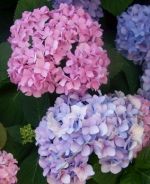
|
||
|
|
|
|
| Forgot Password | ||
Hydrangea Gardening 101
Posted by MariaBBB |
Added on : May 14, 2010 12:01am |
Last edited: June 14, 2010 03:23am | Viewed 3346 times
| 0 Comments | This article is also in blooms
and blooms
Hydrangeas are a popular shrub for the homeowner. From mid-summer until fall, they produce a glorious show in gardens. Versatile shrubs, they thrive in both sandy coastal soils and in shady woodland sites.
 When we think of hydrangeas, we usually think of bigleaf hydrangeas (Hydrangea macrophylla) and mountain hydrangeas (Hydrangea serrata). These are deciduous shrubs that are native to seacoasts and mountain valleys in Japan and divided into two types by the shape of their flowers. Mophead types (sometimes called hortensias) have large, ball-shaped flower clusters. Lacecap types have flat, delicate clusters.
When we think of hydrangeas, we usually think of bigleaf hydrangeas (Hydrangea macrophylla) and mountain hydrangeas (Hydrangea serrata). These are deciduous shrubs that are native to seacoasts and mountain valleys in Japan and divided into two types by the shape of their flowers. Mophead types (sometimes called hortensias) have large, ball-shaped flower clusters. Lacecap types have flat, delicate clusters.
The sheer number of choices among hydrangea species, hybrids, and cultivated varieties can be overwhelming even for the most advanced gardeners. How do you choose from among the hundreds of mopheads, climbers, lacecaps, and oakleafs, to name just a few? And how do you care for hydrangeas in gardens?
One common cause for lack of flowers is too much shade. Hydrangeas do well in partial shade provided by tall deciduous trees. Plant your hydrangeas in an area where they receive morning sun. They also thrive in full sun but may need extra water on hot summer days. (Bigleaf hydrangeas do particularly well in full sun in coastal areas once they are established.) When watering, try one of our new Dramm watering hoses that we now offer online. Offered in a variety of festive and fun colors, Dramm watering tools are the choice of professional and serious gardeners everywhere for their durability and high performance.
Cultural practices are sometimes the cause of the lack of flowers. If hydrangeas are given too much high-nitrogen fertilizer, they may produce lush foliage with few flowers. Good watering practices are also important for healthy plants. Hydrangeas benefit from 1 inch of water a week during summer (unless it rains). Bigleaf hydrangeas in full sun may need up to 2 inches during the hottest summer days.
Winter dieback can be a problem in colder regions. Plant your hydrangeas in a sheltered spot or try creating a burlap windscreen or a burlap frame filled with dry leaves. Winter temperatures tend to be more constant on a north- or east-facing site. The south and west side of your property will heat up in the winter sun and may cause hydrangea buds to open prematurely.
The biggest culprit for a lack of flowers is incorrect pruning. Bigleaf hydrangeas flower on old wood. Hydrangeas tend to need minimal pruning, but if you would like to reduce the size of the plant or prevent it from flopping over too much, technically the best time to prune these shrubs is immediately after flowering. The easiest thing to do at this time is take out some of the older canes, which will reduce crowding and encourage new growth. However, when cold winters kill the tips of the branches, prune in spring. Before the hydrangea starts to leaf out, remove deadwood and cut the stems back to a healthy set of buds. If you have an established shrub, you can also take out several of the older stems at this time. Make sure that you do not remove too many buds; otherwise you will loose your blooms.
 When we think of hydrangeas, we usually think of bigleaf hydrangeas (Hydrangea macrophylla) and mountain hydrangeas (Hydrangea serrata). These are deciduous shrubs that are native to seacoasts and mountain valleys in Japan and divided into two types by the shape of their flowers. Mophead types (sometimes called hortensias) have large, ball-shaped flower clusters. Lacecap types have flat, delicate clusters.
When we think of hydrangeas, we usually think of bigleaf hydrangeas (Hydrangea macrophylla) and mountain hydrangeas (Hydrangea serrata). These are deciduous shrubs that are native to seacoasts and mountain valleys in Japan and divided into two types by the shape of their flowers. Mophead types (sometimes called hortensias) have large, ball-shaped flower clusters. Lacecap types have flat, delicate clusters.



Be the first one to comment on this article